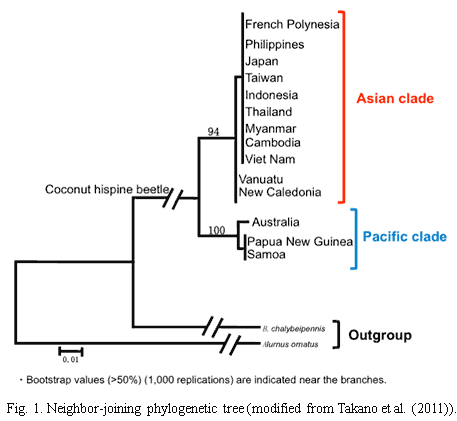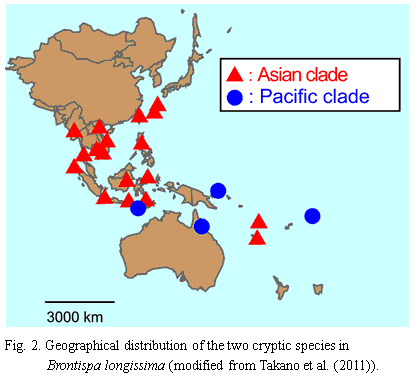Two cryptic species in the coconut hispine beetle, Brontispa longissima
Description
The coconut hispine beetle, Brontispa longissima, is a serious invasive pest of coconut palm, Cocos nucifera. It has recently invaded Southeast Asia and further expansion of risk areas (e.g., into India, Sri Lanka, or Africa) is of great concern. This insect is difficult to control with just chemical pesticides because it stays in young unopened coconut fronds that locate the crown, and coconut trees are too tall for growers to spray pesticides. Moreover, coconut trees are grown near houses and pesticide pollution is a concern; therefore, an alternative to pesticides (i.e., biological control) is necessary.
The larval parasitoid, Asecodes hispinarum (Hymenoptera: Eulophidae), was introduced to Southeast Asia from Papua New Guinea (via Samoa) through a FAO project. To study genetic variation in this species and to determine the place of origin or distribution pathways of B. longissima, we compared partial mitochondrial cytochrome oxidase subunit I gene (COI) sequences of specimens obtained from Pacific, Southeast Asian, and East Asian countries. Because our phylogenetic analysis based on the mtDNA sequences showed that B. longissima comprises two well-defined monophyletic and allopatric groups, we compared life-history traits between the two groups for effective biological control.
Results of our study show that there are two monophyletic groups: one distributed over a limited area (Australia, Papua New Guinea, Samoa, and Sumba Island; referred to as the Pacific clade) and the other dispersed over a wide area of Asia and the Pacific region (referred to as the Asian clade) (Figs. 1 and 2).
Recent invasions and outbreaks have been reported only in areas where the Asian clade has been found. The Asian clade has a significantly longer life span and produces more eggs than the Pacific clade, suggesting that the former has advantageous life-history traits with the potential to become serious pests. To support further study of geographic distribution and effective control, we developed a PCR–RFLP method for differentiating the two clades. Digestion of the PCR product of a 1,014-bp region within the COI with BslI resulted in clade-specific patterns.
The native habitat of A. hispinarum is considered to be Papua New Guinea suggesting that the original host of this parasitoid belongs to the Pacific clade, whereas beetles that invaded Southeast Asia belong to the Asian clade. Another potential natural enemy of the beetle, Tetrastichus brontispae (Hymenoptera: Eulophidae), is distributed, originally from Java, Indonesia, Tetrastichus brontispae (Hymenoptera: Eulophidae), another potential natural enemy of the beetle, is distributed where the Asian clade exists. Therefore, we believe that we should study T. brontispae, which is rather useful as a "real" natural enemy of the beetle in Southeast Asia. We recommend that when B. longissima happens to invade new areas, the clade of the beetle should be examined using our technique before introducing a natural enemy.
Figure, table
- Affiliation
-
Japan International Research Center for Agricultural Sciences Crop, Livestock and Environment Division
- Classification
-
Administration A
- Program name
- Term of research
-
FY 2012 (FY 2006-FY 2010, FY 2012)
- Responsible researcher
-
Nakamura Tatsu ( Crop, Livestock and Environment Division )
KAKEN Researcher No.: 40373229Ichiki Ryoko ( Crop, Livestock and Environment Division )
Takano Shun-ichiro ( Crop, Livestock and Environment Division )
KAKEN Researcher No.: 90725045Murata Mika ( Crop, Livestock and Environment Division )
Huong Nguyen Thi ( Crop, Livestock and Environment Division )
Mochizuki Atsushi ( National Institute for Agro-Environmental Sciences )
KAKEN Researcher No.: 30343825Takasu Keiji ( Kyushu University )
KAKEN Researcher No.: 50212006Konishi Kazuhiko ( Hokkaido Agricultural Research Center, NARO )
KAKEN Researcher No.: 90414747Alouw Jelfina C. ( Indonesian Palmae Research Institute )
Pandin Donata S. ( Indonesian Palmae Research Institute )
- ほか
- Publication, etc.
-
Takano et al. (2011) Ann. Entomol. Soc. Am. 104:121—131
https://doi.org/10.1007/s10340-012-0474-6Takano et al. (2012) J. Pest Sci.
Takano et al. (2012) Entomol. Sci. In press.
- Japanese PDF
-
2012_08_A4_ja.pdf56.13 KB
- English PDF
-
2012_08_A4_en.pdf235.82 KB


